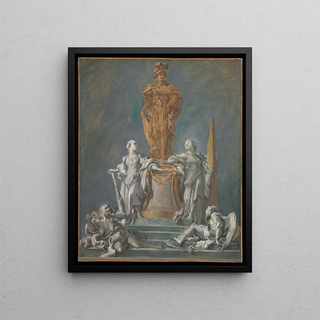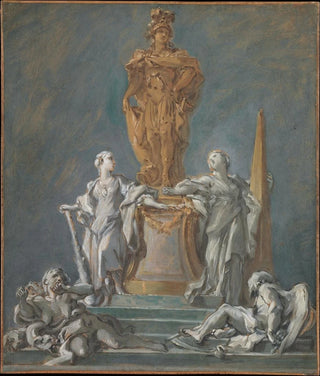Art print | Study for a monument to a princely figure - François Boucher Source: Reproduction | Étude pour un monument à une figure princière - François Boucher


View from behind

Frame (optional)
In the world of art, some works transcend their era to become timeless witnesses of human creativity. "Art print for a study for a monument to a princely figure - François Boucher" is a perfect example. This piece, created by one of the undisputed masters of the 18th century, embodies both the elegance and grandeur of French rococo. Through its delicate lines and refined compositions, Boucher invites us to delve into a universe where the sublime and the profane coexist, offering a window into the society and values of his time. This study, although preparatory, reveals the depth of Boucher's artistic thought and his desire to celebrate nobility in all its forms.
Style and uniqueness of the work
The originality of this work lies in its ability to capture the very essence of princely majesty. Boucher, a virtuoso with the brush, uses shimmering colors and fluid shapes to create an atmosphere of lightness and refinement. The sumptuous draperies and meticulous costume details demonstrate impressive technical mastery. Every brushstroke seems to dance across the canvas, evoking a movement that transcends the usual static nature of monumental representations. The work also stands out for its intimate approach, where the grandeur of the subject is tempered by a delicacy that invites introspection. This duality between power and fragility is emblematic of Boucher's style, which manages to breathe vibrant life into his creations while respecting the canons of noble representation.
The artist and his influence
François Boucher, born in 1703, is often regarded as one of the leading artists of the rococo movement. His career spanned several decades, during which he established himself as the official painter of Louis XV's court. His work is marked by a sensitivity to beauty and a fascination with mythology, nature, and everyday life. Boucher also played a crucial role in redefining the aesthetic standards of his time, influencing many contemporary and subsequent artists. His ability to combine sensuality with a certain lightness opened

Matte finish

View from behind

Frame (optional)
In the world of art, some works transcend their era to become timeless witnesses of human creativity. "Art print for a study for a monument to a princely figure - François Boucher" is a perfect example. This piece, created by one of the undisputed masters of the 18th century, embodies both the elegance and grandeur of French rococo. Through its delicate lines and refined compositions, Boucher invites us to delve into a universe where the sublime and the profane coexist, offering a window into the society and values of his time. This study, although preparatory, reveals the depth of Boucher's artistic thought and his desire to celebrate nobility in all its forms.
Style and uniqueness of the work
The originality of this work lies in its ability to capture the very essence of princely majesty. Boucher, a virtuoso with the brush, uses shimmering colors and fluid shapes to create an atmosphere of lightness and refinement. The sumptuous draperies and meticulous costume details demonstrate impressive technical mastery. Every brushstroke seems to dance across the canvas, evoking a movement that transcends the usual static nature of monumental representations. The work also stands out for its intimate approach, where the grandeur of the subject is tempered by a delicacy that invites introspection. This duality between power and fragility is emblematic of Boucher's style, which manages to breathe vibrant life into his creations while respecting the canons of noble representation.
The artist and his influence
François Boucher, born in 1703, is often regarded as one of the leading artists of the rococo movement. His career spanned several decades, during which he established himself as the official painter of Louis XV's court. His work is marked by a sensitivity to beauty and a fascination with mythology, nature, and everyday life. Boucher also played a crucial role in redefining the aesthetic standards of his time, influencing many contemporary and subsequent artists. His ability to combine sensuality with a certain lightness opened






